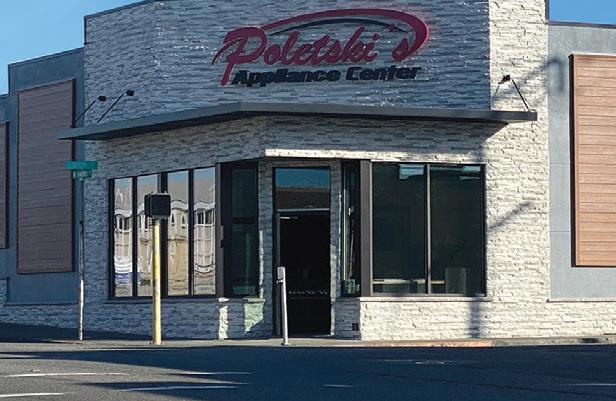
6 minute read
Get Out
341 West Harris St., Eureka 707 445-3138 poletskis.com



• Servicing Humboldt County for over 40 years • Largest in stock new & used inventory • Competitive price guarantee • Delivery and Service after the sale




“LARGEST BRAND SELECTION IN THE COUNTY”
Sea to Summit: Schoolhouse Peak

By Hollie Ernest
getout@northcoastjournal.com
Iwoke up later than I meant to, which has been the case for most of my days on this earth. I’m always trying to squeeze too much into a day but I’d rather have the bucket overfl ow than be sitting still, wondering what to do. Even when I’ve been without a job, I’ve always got so much to do. In the words of my fellow Tennesseean, the great Dolly Parton, “I wake up with new dreams every day .... The second my feet hit the fl oor, I’m awake. I’m like, hurry, hurry. I just love life. And I feel like we ain’t got but a certain amount of time anyway. I want to make the most of all of it.”
It was the Monday after a weekend spent backpacking with friends and I needed to work on my book, but my discipline was wavering. When dawn broke with sunshine and no fog, I decided to drive north. It would be an impromptu solo day trip with me and my road bike, a 44-mile out-and-back to Schoolhouse Peak for another Sea-to-Summit mission. I parked at Freshwater Lagoon and watched the windswept clouds play tag above the shoreline with my toes in the water. It was sunny, then not, then sunny again.
I started pedaling up the steep switchbacks on Bald Hills Road, heart pumping hard. I had ridden this ascent just over a week prior and enjoyed the familiarity. Each switchback has its own landmarks of leaves and plants. The trailer and RV tra c increased, and I cursed myself for my late start.
My legs burned as I stood out of the saddle and up through the fog I climbed, quads still sore from backpacking, but overall feeling good. Past Ladybird Johnson Grove, I emerged into the tawny and amber August hills and felt ecstatic to be alive. I just kept moving forward and let my mind wander. The pandemic, marginalization, evolution, the Yurok Tribe whose land this is, the invasive harding grass (Phalaris aquatica) that dominates parts of these hills and the California fescue (Festuca californica) that is the underdog in that fi ght.
As usual, the ride up took longer than expected, the khaki ribbon of road unfurling for what looked like forever in front of me. I had to walk the last bit on loose gravel up to the o cial summit, the fi re lookout tower on Schoolhouse Peak at 3,096 feet. The fi re tower was constructed in 1941 and has incredible panoramic views of Redwood National Park and beyond. It’s been modifi ed and modernized from its original wooden structure, and now has tall metal walls leading up to an enclosed tower.
I sat out of the wind below the tower and ate my snacks, gazing out to the east. Even from ground level I could see the Salmon and Red Cap fi res. The Salmon Mountain fi re started on July 27, 2020, two short days after I had stood on the mountain’s mighty fl anks. The man stationed at the Schoolhouse lookout told me the fi res were merging and stood at 2,700 acres. That felt large at the time, but we knew it would spread rapidly and get much larger in that steep terrain. By the end of August, it became known as the Red Salmon Complex and reached over 20,000 acres. It kept burning into November, reaching 145,000 acres, and stretched from its start in the Trinity Alps Wilderness to the Klamath, Six Rivers and Shasta-Trinity National forests. It burned near Hoopa Valley, Willow Creek, Salyer, Denny, Forks of Salmon, Orleans and Cecilville.
As I stared at the smoke in the distance, I couldn’t help but wonder if these fi res would not be so severe or intense if we’d had more “good fi re,” in the past decades. Sometimes natural and more often prescribed, these are low-intensity fi res that clear out the underbrush and reduce the fuel load without setting an entire forest ablaze. The practice is traditional among local Native tribes. Our ecosystems have evolved with fi re and continue to need it as part of a cycle. Natural fi res have been part of this cycle for centuries but after 100 years or more of fi re suppression, fuel loads in our forests have built up to create quite the precarious brush pile.
Lenya Quinn-Davidson, our Area Fire Advisor, wrote on the Fire-Adapted Communities blog about the relationship between humans and fi re, “Fire, smoke, water temperatures, fi sh, people, forests: we’re all the same, aren’t we? We’re all su ering simultaneously from too much fi re and not enough of it. The paradox is soul-bending.” I let my mind wander further along the path of fi re management as I pedaled in the opposite direction of the smoke and fl ames back towards the humid, salty air of the coast. To my left were meadows that were burned strategically in 2019 and will continue to be burned when appropriate, when conditions allow. To my right, to the north, the forest was thick with second-growth conifers.
The rolling hills on the return journey seemed to multiply, and my heavy legs argued with my brain over whether this was possible. Down shady switchbacks on rough roads, the air cooled down and I was enveloped in shadowy redwoods once again. Back at my car, I said goodbye to the crashing surf and hurried home, wanting a nap but lacking the time. Dolly’s words, “hurry, hurry,” cursed me as I hastily made dinner for two friends who were coming over for an outdoor, socially distanced dinner. I made burgers and charred poblanos stu ed with corn risotto. In my frenzy, I almost burned the burgers, but once the guests arrived, we got lost in conversation, catching up on lives and adventures. The hurry melted into the risotto. We squeezed in the last of the day’s sun around a backyard fi re, spent a few more minutes watching the stars come out and let a few things overfl ow into the bucket for tomorrow. ●
A view from the Schoolhouse Peak summit. Photo by Hollie Ernest Hollie Ernest (she/her) is a botanist and forestry technician on hiatus from an international bike tour. She is writing a book about her travels, gardening and exploring the corners of Northern California. Follow her on Instagram @ Hollie_holly.











